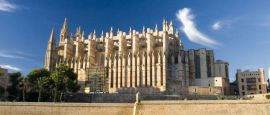Originally home to Mallorca’s Moorish rulers and expanded for the Catalan kings, the “palace of the citadel” in Palma is a graceful mix of Moorish, Gothic and Renaissance styles. It was an official island residence of King Juan Carlos I before his abdication in 2015. The gardens and fountains are beautiful.
Mallorca things to see and do
Tourist offices
Address: 6th Floor, 64 North Row, London, W1K 7DE, United Kingdom
Tel: +44 207 317 2011.
Opening Hours: By appointment only, from 0900-1600 Mon-Thurs and 0900-1400 Fri.
www.spain.info/uk
Address: Suite 5300 (53rd Floor), 60 East 42nd Street, New York City, NY, United States
Opening Hours:
This office is not open to the public; enquiries via the website only.
www.spain.info
This unusual, round, 14th-century castle surrounded by forests and paths offers breath-taking views of Palma de Mallorca. Formerly a royal residence it now houses an excellent museum, including a collection of classical sculptures. The castle is located on a hill above the city and is a major feature of Palma’s skyline.
Weekly town markets are an important part of Mallorcan life, and Inca’s market is one of the biggest. Stalls fill the town centre where everything from toys to flowers to fruit and vegetables are sold. It's most famous for its leather goods including wallets, belts, bags and shoes.
At Mallorca's easternmost pinnacle lies the Formentor cape, one of the most picturesque parts of the island. Tall cliffs dip into deep blue seas, sporadic pine trees grow along its shore and seabirds swoop overhead. A winding road weaves along the coast here, providing the most spectacular views.
La Sierra de Tramuntana Mountains run ragged across Mallorca's northern coast, offering scintillating views and challenging bike rides, with a diverse mix of calas and rocky outcrops dotted along the way. Steep cliffs drop into the blue sea below and picturesque villages such as Deiá perch on the mountainsides.
The long and multi-faceted history of Palma is well preserved by its old city, where cobbled streets, stout city walls, grand courtyards and gothic buildings beg to be explored. Busy shopping streets, grand squares, pavement cafés, chic restaurants, trendy bars and a flourishing art scene bustle with locals and tourists alike.
Tucked high in the Tramuntana Mountains is the quaint, cobbled-lane village of Valldemosa. At its heart is the medieval Royal Monastery complex (the Real Cartoixa), which is associated with the French writer George Sand and composer Frédéric Chopin, who shared a room here in 1838-39. It's a magical little town in a beautiful setting.
This rural finca (farm) in the mountains is surrounded by tranquil gardens and has been beautifully preserved to show a traditional Mallorcan working farm. La Granja hosts craft demonstrations and folk dancing (Wednesday and Friday afternoons). There are also displays of antique furnishings, costumes, food tasting and farm animals.
High up in the Tramuntana Mountains is Lluc monastery, Mallorca’s most famous pilgrimage destination. Since the 13th century, pious Catholics and others have made their way here to pay homage to La Moreneta, “the little dark one”, a statue of the Virgin Mary. There is also a simple but unique hostel inside the monastery.
Although the Balearic Islands have started to move on from their party image in recent years, they still attract many visitors keen on irreverent nightlife. There are several “super clubs” in Mallorca, many of them in Palma's trendy Paseo Maritimo district. And if all else fails, there's always Magaluf.
One of Britain’s most famous war poets, after a tumultuous life in the trenches – and a somewhat colourful life in London – the venerable writer moved to Deiá, a sleepy Mallorcan village where he wrote his most celebrated works. Fans can explore his rambling villa, which is home to a small but informative museum, and visit the late poet’s grave in the nearby cemetery.
The crystal waters encircling Mallorca are perfect for sports. The island is a popular yachting destination, while the warm sea is ideal for swimming, snorkelling, diving or kayaking. Day boat cruises are a great way to see the coast and there are many excursions that can be booked locally.
The Palma Sóller Railway is the best way to get to the charming, traditional town of Sóller, nestled amongst the Tramuntana Mountains. The vintage wooden 1912 locomotive makes a scenic 27km (16.7 miles) trip through mountains, forests and olive and orange groves offering spectacular scenic views of rural Mallorca.
S 'Albufera Nature Reserve in Alcúdia bay is a large tranquil area of marshy coastline formed by lakes, and natural and artificial canals. The park is home to 200 species of bird, a huge variety of plants and wildflowers, insects, fish, and some unusual amphibians, reptiles and mammals.
Walk through the fairy-tale world of the “dragon's cave” on the island's northeast coast. You'll pass fantastically shaped stalagmites, beneath a million needle-shaped stalactites, before reaching an amphitheatre for the grand climax – an unforgettable classical concert on an underground lake. The tour is guided in several languages.
Mallorca’s coastline is pocketed with natural coves, whose clear sparkling waters attract sailboats, traditional fishing boats and are perfect for swimming in. Of these Cala Pi, Cala D’Or and Sa Calobra are particularly beautiful. Golden beaches can be found all around the island. Some especially attractive ones are Es Trenc, Alcúdia and Sa Coma.
The cathedral is a splendid example of Gothic architecture, remarkable for its vast size and stained glass windows. Construction began 1306 and continued for four centuries. It was remodelled by Gaudí from 1902 to 1914. Beautifully illuminated at night, the cathedral is Palma de Mallorca’s most famous landmark.
Do you have any Feedback about this page?
© 2025 Columbus Travel Media Ltd. All rights reserved. No part of this site may be reproduced without our written permission, click here for information on Columbus Content Solutions.








 You know where
You know where